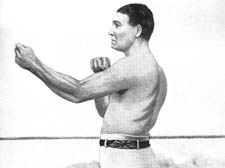|
|
 |
| |

Tom Sayers |
Our champ who took on the Yank
Richard Osley tells how north London’s Tom Sayers came battling out of the British corner in the world’s first transatlantic bout
The Lion and The Eagle. By Iain Manson.
Sports Books £14.99
NO offence to the population of the town in Hampshire which prides itself on an annual air show and its nearby military base, but Farnborough isn’t the first place which springs to mind when it comes to historic sporting venues.
Yet long before the gold-plated rings of Las Vegas were even a twinkle in the dollar-crossed eyes of boxing promoters, before Caesar’s Palace, rumbles in jungles and thrillers in Manila, boxing had Farnborough.
And before Joe Louis, Henry Cooper, Ali, Sugar Ray and Rocky, boxing in a more primitive form had Tom Sayers, the best British fighter of the Victorian age whose grave in Highgate cemetery remains guarded by a stone statue of his dog, Lion.
Ten thousand followed his body as it was wheeled to that final resting place through the streets of Camden Town and Kentish Town – even though his profession as a prize-fighter was banned at that time. He had often been hailed as a hero for his almost unbeatable record against the best heavyweights of his time – Sayers lost against just one.
But, as sports historian Iain Manson points out, his popularity soared particularly after his exploits in a meadow in Farnborough on April 17, 1860. There, Sayers fought American boxer Jack Camel Heenan, the so-called “Benicia Boy”, in the first transatlantic bout, a kind of Dickensian Cooper versus Ali, or Tyson versus Bruno.
Even though it was outlawed – the chosen venue was relayed through London’s drinking circles – the fight gripped the attention of two nations in a way that only TV dancing contests can do these days.
Certainly Dickens, then working as a journalist, and even Lord Palmerston, the Prime Minister, were among those drawn to the fervour around what might be considered the last bare-knuckle battle before boxing was able to go legit.
Sayers and Heenan traded blows for 37 rounds and for more than two hours. British newspapers broke with tradition and carried reports of the epic encounter, while the old New York Clipper newspaper declared: “The excitement regarding the news eclipsed anything we ever saw in the newspaper world.”
Nobody can quite say for certain who won. The bout ended in disarray when the makeshift ring’s ropes were cut and police intervened to halt a riot among the thousands. By the end, Sayers was bloodied and could hardly raise his right arm. Heenan’s eyes were so puffed up so he could hardly see his opponent.
This legendary, albeit savage chapter in the development of boxing has never been more dutifully studied than in Manson’s The Lion and The Eagle. He has sifted through every possible journal, newspaper extract, police and government record to unearth the stories behind the two competitors.
Sayers was born in the poor Pimlico end of Brighton but Camden has already claimed him as one of its own; a blue plaque is stapled to the wall of the flat in Camden High Street which he spent his adult days.
Aside from the blood-curdling tales of secret fights, Manson’s book is often a trail around Victorian Camden, with many of anecdotes from the bars of Bayham Street.
As Sayers’ bittersweet life story unfolds it is interesting to see what aspects of his Camden life are still standing. For example, Mr Cockin’s Bull and Last pub – still in Highgate Road but without Mr Cockin’s prefix – gets a mention. Manson says it was once considered the borough’s northernmost watering hole.
Fifteen decades after Heenan and Sayers, boxing has been sanitised by dancing girls, the fluff of Don King’s hair and the glitziest of television coverage.
The boxers of Farnborough were knocking seven bags of stuffing out of each other without gloves, crude medical back-up and a referee who scarpered halfway through the bout. That sounds more stupid than heroic.
Maybe Sayers’ real heroism is the link he unwittingly forged between rich and poor in a country divided by class. Enthralled by his exploits, the London Stock Exchange and Houses of Parliament whipped up a collection to ensure he had a comfortable retirement financially.
“The most august bodies in the land were falling over themselves,” Manson points out, “to reward an illiterate member of the working class for his indulgence in an illegal activity which many viewed with utter disgust.” A shame then that Sayers only had five years of retirement to enjoy before they trooped him up to Highgate at the age of 39, after he succumbed to TB.
• |
 |
|
 |
| |
|
 |
|


